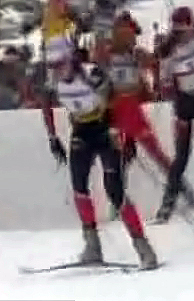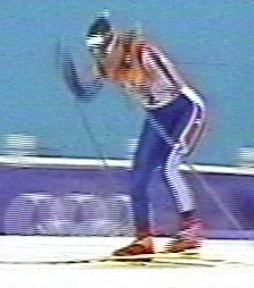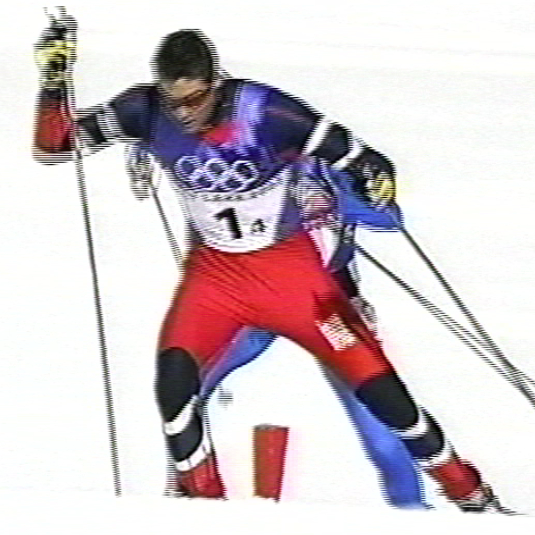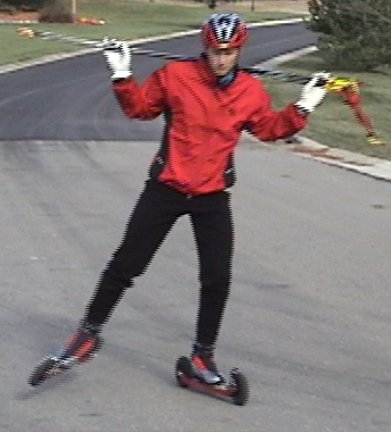| Silent Sports Articles |
| Lee |
| Purchasing DVDs/Videos |
| Lapham Peak SnowMaking |
| The Master Skier |
Interactive Video Illustrationsfor my articles in The Master SkierRace Season 2007: Skate Like a Bullet - Part 3.
Note: Part two of this series described how to add poling without destroying the pure leg skate-off developed with no-poles skating. There are no specific video links for this article but there are many short clips on this site that illustrate poling while skating.
Fall 2006-7: Skate Like a Bullet - on snow or ROLLER SKIS.
Note: Step two and three are the usual “missing links” when skating with or without poles is described. Step two: Imagine your upper body is a huge bullet. Your goal is to send this bullet into pure glide without sideways pressure. Trying to skate to the side too early kills both balance and a powerful popping skate-off. Then when you sense you are about to lose momentum, move to step three. Note: See video sequences below. Step three: This step involves a slight rise and unweighting and is the key to powerful skating. Only apply pressure after this upward “hitch.” If you push any sooner, you kill glide. In faster conditions your skis will point more forward and you will glide longer before the up-hitch and skate-off. In slower conditions the skis will be angled out more and the unweighting to skate move will occur much earlier. There is a hidden benefit to slightly unweighting your ski prior to pushing off. The leg is cocked or “set” for a sharper and more powerful acceleration. It’s similar to the backswing in golf. It’s a gathering of the body for an explosive, yet effortless, skate-off. Note: See video sequences below. Step four: Now all that’s left is an aggressive move to the next ski. This sharp motion will propel your entire upper body over the next ski for the next cycle. The overall sensation is one of continuous motion. The pendulum of your body never stops swinging and your legs stay dynamic. Even while you are in a pure glide the off leg is continuously swinging in and forward, subconsciously timed to be ready for the next skate-off. And when you get it, it’s like dancing on snow. ADDING POLING 
Finally apply YOUR natural skating motion without poles to the various skates with poles. This applies equally to the V-1, V-2, Flying Herringbone or Open Field Skates (V-2 Alternate). Your goal is to ingrain the feeling of complete weight transfer from side-to-side followed by a distinct unweighting and an aggressive push-off to the next ski. This sensation should feel the same with or without poles. If it doesn’t, intersperse no-poles skating to recapture the feeling of “your” pure skate. Stick with it and soon you will feel like a bullet, speeding down the trail with less effort than you thought possible. And you will forever leave the world of internal braking, one muscle fighting another. Next issue will look more deeply into adding poling to your skates. Fall 2005-6: The Upright Trend in World Cup Skiing.Summary: Last season there was a growing trend, both in cross country and biathlon, to a more upright style of skiing - very similar to that of the great Thomas Alsgaard. France's Sandrine Bailly won the overall women's biathlon title and Germany's Axel Teichmann was men's XC champion, both skiing with a more erect posture. However, most athletes on both circuits still skied with pronounced flexion and many were quite bent over. Click here to view entire article. So, which is best for you? Unfortunately, there isn't a simple answer to that question. Individual variables (such as torso vs. leg length) mean everyone has their own "ideal" posture. I suggest that you view the following clips, then head out to a ski trail and experiment until you find YOUR most efficient way to ski.
So, which is best for you? Unfortunately, there isn't a simple answer to that question. Individual variables (such as torso vs. leg length) mean everyone has their own "ideal" posture. I suggest that you view the following clips, then head out to a ski trail and experiment until you find YOUR most efficient way to ski.And remember, if you have Quicktime, you can use the arrow keys to view the video in slow motion. (You may have to use your mouse to stop the video first for the arrow keys to work.) For Media Player, see your help menu for slow motion setup. Video Clips: Click on the best choice for your computer. Midseason 2005-6: Adapting the V-2 to the Steeper Hills.Summary: While the V-1 is still the stroke for steeper hills, each year the world's elite climb tougher and tougher ascents using the V-2. But the V-2 of the flats is not quite the same as used on the steeper hills. While both share the same timing (of poling with each skate), there the similarity ends. On fast sections, the skis are pointed relatively straight forward and the glide phase is longer. But the point of emphasis in this article was that V-2 poling, on the flats, looks a lot like the normal double pole. However, that changes when the hills get steeper; then the skis are more angled out and the entire stroke is shorter. This means that the stomach and lats carry a bigger part of the poling load, the final triceps extension being shorted and even eliminated.
On fast sections, the skis are pointed relatively straight forward and the glide phase is longer. But the point of emphasis in this article was that V-2 poling, on the flats, looks a lot like the normal double pole. However, that changes when the hills get steeper; then the skis are more angled out and the entire stroke is shorter. This means that the stomach and lats carry a bigger part of the poling load, the final triceps extension being shorted and even eliminated.But the biggest modification, to the V-2 on steep hills, is a marked change in the position of the hands. They are no longer working as mirror images of each other. The steeper the climb, the more closely they resemble the asymmetric (offset) hand positions of the V-1. Click here to view entire article. Video Clips: Click on the best choice for your computer. Issue Three 2005-6: The Universals of SkatingSummary: There are certain universals that are seen in all skating strokes, from the steepest hills to the fastest flats. Video Clips
Video Clips
Finally, feel free to look for the "universals of skating" in ALL of the previous video clips. I hope these "moving illustrations" have been a help. |
 The following is a short summary of my article (Honing Your Skate to its Ultimate - Skate Like a Bullet) in the Fall edition of The Master Skier. The short (moving illustrations) video clips hopefully will help to implement these drills. Click on the link in the sidebar if interested in subscribing to The Master Skier , where this article is featured completely, as well as many other cross country articles covering all the different areas of our sport.
The following is a short summary of my article (Honing Your Skate to its Ultimate - Skate Like a Bullet) in the Fall edition of The Master Skier. The short (moving illustrations) video clips hopefully will help to implement these drills. Click on the link in the sidebar if interested in subscribing to The Master Skier , where this article is featured completely, as well as many other cross country articles covering all the different areas of our sport.